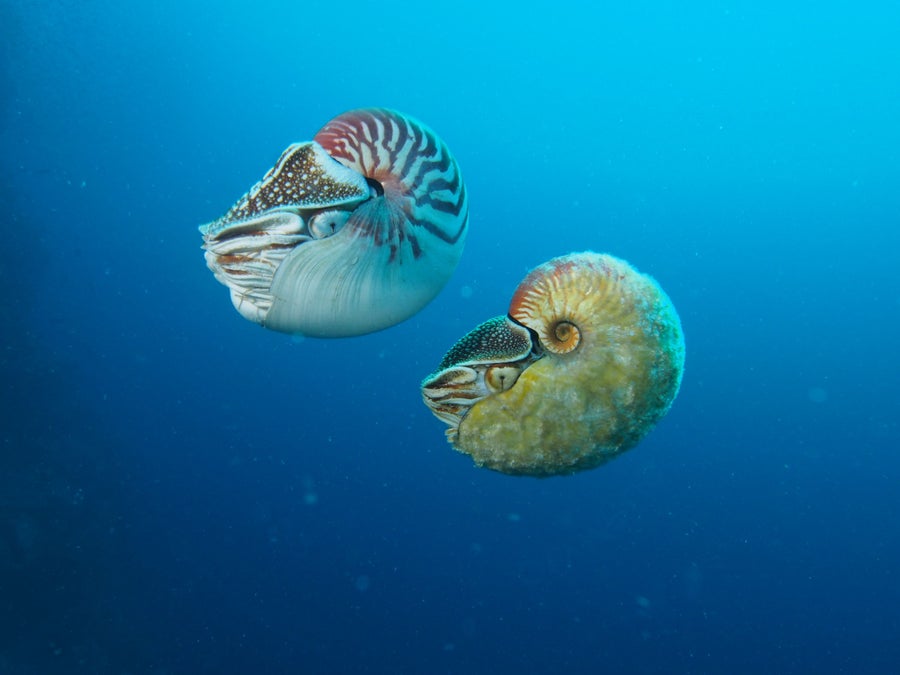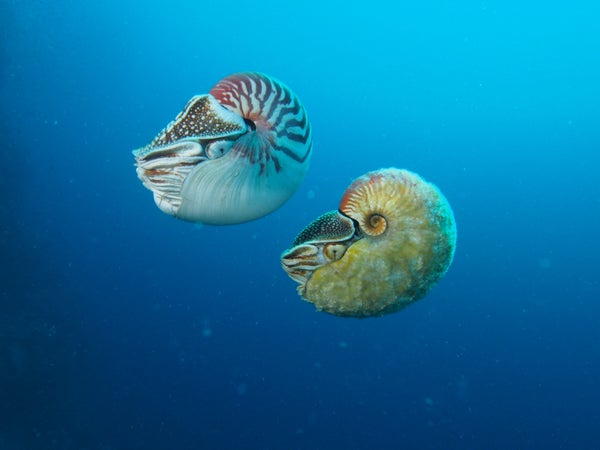This article was published in Scientific American’s former blog network and reflects the views of the author, not necessarily those of Scientific American
This could be the closest you’ll ever get to seeing a living, breathing jawbreaker that’s been sucked on, rolled across the carpet, and left to get real hairy under the couch for about six months. Meet the crusty nautilus (Allonautilus scrobiculatus), one of the rarest known marine animals on Earth.
First discovered in 1984 and sectioned off into its own genus in 1997, this hairy slimeball hasn’t been seen in more than three decades. Photographed off the coast of Papua New Guinea’s Ndrova Island alongside the largest and best-known nautilus species - the chambered nautilus (Nautilus pompilius) - the crusty nautilus is found exclusively in this tiny pocket of ocean, as far as we know.
Which is bad news for their continued survival, but just as everything you’ve lost is right where you left it, the species’ tiny range meant it was always there for the photographing - it just needed a team patient enough to bait it out of hiding. Funded by National Geographic and the US National Science Foundation (Polar Programs), biologist Peter Ward from the University of Washington and his team set out to catch a glimpse of this honeycomb-hued cephalopod in the last place it was spotted.
On supporting science journalism
If you're enjoying this article, consider supporting our award-winning journalism by subscribing. By purchasing a subscription you are helping to ensure the future of impactful stories about the discoveries and ideas shaping our world today.
.jpg?w=612)
Allonautilus scrobiculatus (Credit: Peter Ward)
The aim was firstly to confirm if the species was still actually in existence, because having seen local populations of nautiluses be fished to extinction in the Phillipines, there was a good chance the same thing had happened to our crusty friends in the three decades since we’d last seen them.
If the team managed to find any, they planned to capture the first digital photographs and footage of it, plus collect tiny snippings of flesh from any live specimens they encountered so they can better understand the species’ genetic make-up, and also try and figure out where it fits into the 500-million-year-old nautilus lineage alongside the five other known species. And yep, those 500 million years mean these creatures were undulating quietly through the world’s oceans around 270 million years before dinosaurs were even a thing.
To lure them into the vicinity of their deep sea video cameras and acoustic transmitters, Ward and his team attached some nautilus bait - fish and chicken meat - to a stick, and lowered it to a depth of between 150 and 300 metres, turning the camera on it for 12 hours at a time. And then they would wait.
Taking turns to hang out in the tiny boat that anchored their bait stick, the team - which also included Greg Barord, "whose recent PhD on nautilus biology is changing our understanding of this animal”; biologist Rick Hamilton of the Nature Conservancy; and Manuai Matuwae, local chief of conservation for the Manus Island area - surveyed the spot for six days and five nights straight.
And it all paid off, allowing them to not only film the local population, but also to capture several nautiluses at a depth of around 200 metres to take skin samples before releasing them at the depth they were found. Ward describes the experience at National Geographic:
"The great joys were the moments we retrieved our traps to find nautiluses, the times we would swim with them, and especially when we pulled our giant, heavy deep-water video systems from the sea and spread out on the lawn on our small island.
We’d bring our entire, 40-person clan together and watch the premiere of each 12-hour movie of the night before (played back faster than normal) to watch the nautiluses, deep-water sharks and other fish, and invertebrates of every stripe march into the camera’s field of view in search of the rich fish bait attached to its bright light."

Nautilus pompilius (left) swimming next to a rare Allonautilus scrobiculatus (right) Credit: Peter Ward
And wowow are these things photogenic. When you see it floating alongside the chambered nautilus in the picture above, you can see why it was allocated its own genus – both its shell shape and soft anatomy are what Ward calls "astoundingly different" from those of its more common cousin. Plus there’s that strange velvety coat that only the crusty nautilus has managed to acquire.
"The first time we picked them up, we almost dropped it. It's the most slippery thing," Ward told Elizabeth Goldbaum at Live Science, adding that this is probably a defence mechanism. If a large fish tries to eat one – baring in mind that the biggest crusty nautilus we’ve seen is about 21 cm long – the slippery shell will simply slide away, again and again. "It's really a very cool way not to get eaten," says Ward.
SURE IS. * Fills bathtub with olive oil in preparation for the zombie apocalypse.*
While Ward and his colleagues are yet to fully analyse their footage, acoustic recordings, and skin samples, what they were able to capture during these six days painted a telling picture of tenacity. Apparently the crusty and chambered nautiluses battled it out to get access to the bait before a sunfish turned up and acted like an even bigger jerk than the two quarrelling nautiluses combined. "For the next 2 hours, the sunfish just kept whacking them with its tail," Ward says in a press release.
So the good news is we now know that crusty nautiluses still exist, and while we can’t know for sure how many are down there, from the pictures we’ve got, they appear to be thriving. The bad news is they might not be for much longer. "This part of Papua New Guinea where uniquely in the world two genera of nautiloid cephalopods live is slated soon for large-scale, deep-water mining that will dredge the sea floor, a seafloor above which these ancient survivors still live," Ward writes for Nat Geo.
Let’s hope the discovery is enough to move that project elsewhere, because look at these things. Keep and eye out for the footage, it’ll presumably turn up in some kind of Nat Geo documentary at some point.
